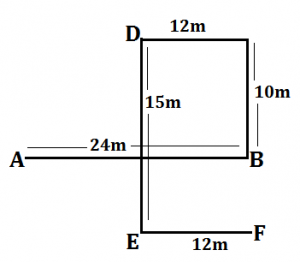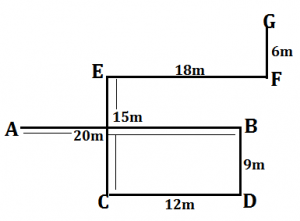Directions (1-5): In these questions, relationship between different elements is shown in the statements. These statements are followed by two conclusions:
(a) If only conclusion I follows.
(b) If only conclusion II follows.
(c) If either conclusion I or II follows.
(d) If neither conclusion I nor II follows.
(e) If both conclusion I and II follow.
Q1. Statements: K ≤ M < B ≥ W < R ≥ S = T
Conclusion: I. R > K
II. K ≤ R
Q2. Statements: R > L ≤ U < N > P = T > E
Conclusion: I. N > L
II. P > E
Q3. Statement: W ≥ D = O ≥ T ≥ E ≥ S < R
Conclusions: I. D > S
II. S = D
Q4. Statement: M ≤ N > Y = T > O ≥ P = Q
Conclusions: I. N ≥ P
II. Q < Y
Q5. Statement: U ≤ V < W =X < Y ≥ T ≤ I
Conclusions: I. Y > U
II. T > V
Direction (6-7): Study the following information carefully and answer the given questions:
A person starts walking from point A to the east direction and walks 24m to reach at point B. From point B he takes two consecutive left turns and walks 10m and 12m respectively and reach at point D. From point D he walks in south direction and walks 15m to reach at point E, then finally turn his left and walks 12m to reach final point F.
Q6. What is the direction of his starting point with respect to point D?
(a) North-west
(b) South-West
(c) North-east
(d) South
(e) None of these
Q7. If point O is the midpoint of point A and B, then what is the shortest distance between point O to his final position?
(a) 15m
(b) 12m
(c) 10m
(d) 13m
(e) None of these
Direction (8-10): Study the following information carefully and answer the given questions:
Point A is 20m west of point B, which is 9m north of point D. Point F is 6m south of point G. Point E is 15m north of point C. Point F is 18m east of point E. Point C is 12m west of point D.
Q8. What is the direction of point G with respect to point D?
(a) South
(b)North-east
(c)South-west
(d)East
(e) None of these
Q9. What is the shortest distance between point E to point A?
(a)12m
(b)18m
(c) 25m
(d) 10m
(e) None of these
Q10. What is the direction of point A with respect to point C?
(a) North-West
(b)South-East
(c)North-East
(d) West
(e) None of these
Directions (11-15): In these questions, relationship between different elements is shown in the statements. These statements are followed by two conclusions:
(a) If only conclusion I follows.
(b) If only conclusion II follows.
(c) If either conclusion I or II follows.
(d) If neither conclusion I nor II follows.
(e) If both conclusion I and II follow.
Q11. Statements: P≥Q, U>V=W, P >R≤V, U<S
Conclusion: I. W<S
II. W≤Q
Q12. Statements: D≥A, B<F, E>A>B, G>D
Conclusion: I. E>G
II. G>F
Q13. Statements: Z<W=V, Y≥W, Z≥U, X≤V
Conclusion: I. Y>U
II. W≥X
Q14. Statements: A≥H, C=B<H, D≥A>L
Conclusion: I. B≤D
II. L<H
Q15. Statements: Q=M, K>S≥M, P≥S, R≤Q
Conclusion: I. P>R
II. R=P
Solutions
S1. Ans. (d)
Sol. I. R > K(False)
II. K ≤ R(False)
S2. Ans. (e)
Sol. I. N > L(True)
II. P > E(True)
S3. Ans. (c)
Sol. I. D > S(False)
II. S = D(False)
S4. Ans. (b)
Sol. I. N ≥ P(False)
II. Q < Y(True)
S5. Ans. (a)
Sol. I. Y > U(True)
II. T > V(False)
Solutions (6-7):
Sol.

S6. Ans. (b)
S7. Ans. (d)
Solutions (8-10):
Sol.

S8. Ans. (b)
S9. Ans. (d)
S10. Ans. (a)
S11. Ans. (a)
Sol. I. W<S (True)
II. W≤Q (False)
S12. Ans. (d)
Sol. I. E>G (False)
II. G>F (False)
S13. Ans. (e)
Sol. I. Y>U (True)
II. W≥X (True)
S14. Ans. (d)
Sol. I. B≤D (False)
II. L<H (False)
S15. Ans. (c)
Sol. I. P>R (False)
II. R=P (False)





 GA Capsule for SBI Clerk Mains 2025, Dow...
GA Capsule for SBI Clerk Mains 2025, Dow...
 The Hindu Review October 2022: Download ...
The Hindu Review October 2022: Download ...
 ECGC PO Scorecard 2025 Out, Check Marks
ECGC PO Scorecard 2025 Out, Check Marks




